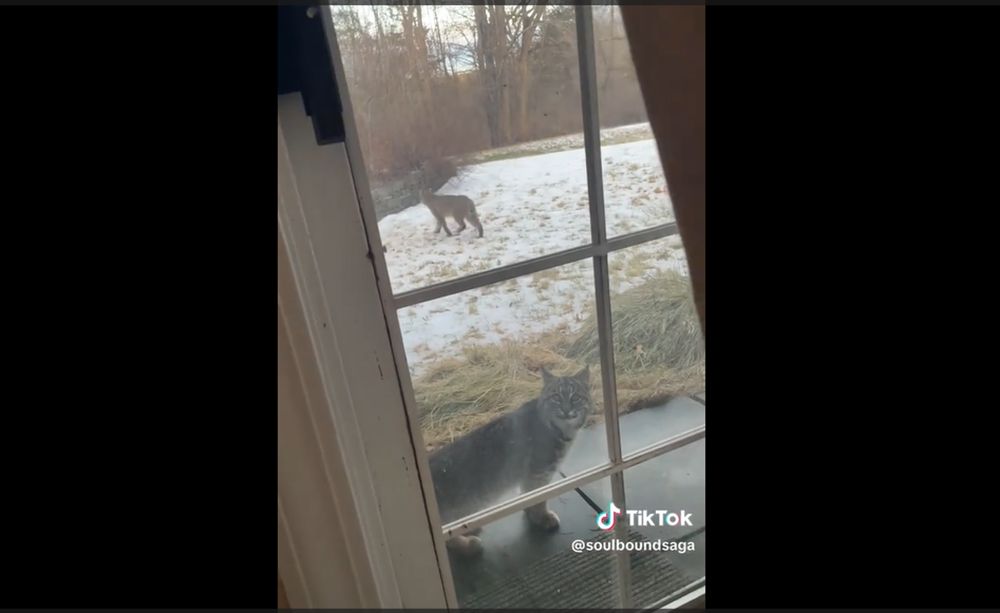
@soulboundsaga / TikTok.com
In a TikTok video that went viral, a black cat is standing behind a glass wall, staring and meowing at whatever the cat has spotted in the yard on the other side of the glass.
“What’s wrong?” the cat’s owner says.
“Meow!” the female cat named Shadow replies.
“What?” he says.
“Meow!” she repeats.
“Baby girl, what’s going on – OH!” the man says, startled at the sight of a baby bobcat lurking outside.
“Uh, oh. Yeah, that’s different!” the TikTok user named @soulboundsaga says in the video.
“I thought she was yelling at birds again,” he wrote in the caption. “I was NOT expecting that!”
He looks up and sees that the juvenile bobcat is not alone; another adult bobcat, perhaps the mother, looms in the background. The homeowner sounds nervous, and I don’t blame him; bobcats are wild animals and not something we expect to find in our yards!
The baby didn’t seem at all phased by the sight of Shadow, a domestic shorthair, on the other side of the glass. But Shadow and her human surely were anxious. He thanked his cat for letting him know about their wild outdoor intruders.
The video got close to 6 million views within just a few days. The more than 10,000 comments are funny and speculative about what the felines are thinking.
“Bobcat is like “you live in there? With HIM? That’s different,” one user said.
Another user commented: “Baby bobcats say MOM LOOK AT THIS MINI PANTHER!”
One person said: “The bobcat cub is so stinking cute!!!”

@soulboundsaga / TikTok.com
Speaking of bobcats – part of the Lynx genus – what are identifying traits of a bobcat, and how are these wild felines similar to and different from our housecats?
Bobcats are often confused with three other lynxes: Canadian, Iberian, and Eurasian. But bobcats are a bit smaller than these other wild cats, and they prefer a different climate. The other lynxes live in frigid northern climates and are cut out for long winters and snow. Back in November 2024, we wrote about a rare Canada lynx that had been spotted roaming Vermont several times. Many Vermont residents had confused the Canada lynx with a bobcat, which is much more common in Vermont.
Bobcats, unlike their cousins, typically live in warmer climates; I grew up in Arizona, and remember hearing people talking about bobcats in the desert. Still, bobcats – most of which live in the United States – are very versatile. They do live in the desert southwest, but they also live in northern forests, coastal swamps, and bottomland hardwood forests.
Bobcats don’t come in a rainbow of colors like domestic cats. They all range in shade from buff to brown, often tinged with red, and with spots and stripes of brown and black. They have bobbed tails, tufts on their ears, and white spots near the tips of their ears.
These felines may be beautiful and look similar to our housecats – they are both members of the Felinae subfamily of the Felidae family – but they are not domesticated. If you find a baby bobcat and are tempted to bring it home and raise the feline just like a domestic kitten, but please don’t; it won’t work out well, either for your house or the bobcat. The two types of cats may be close cousins, but they have different needs and only one – the housecat – is adaptable to sharing a home with humans. We published this article about the reasons why the bobcat would not make a good pet.
If you feel intrigued by the idea of having a pet cat with a little bit of exotic wildness in it, consider getting a Bengal or a Savannah, both of which have wild ancestors yet make purrfect pets.



